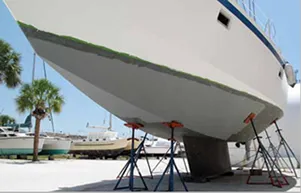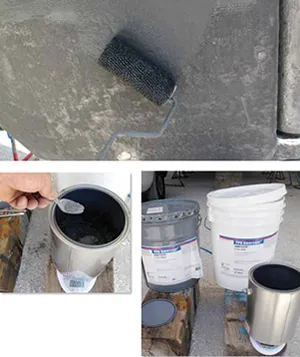
301
Editor’s Note: This is a preliminary field test and should not be regarded as an endorsement of Amercoat PPG, a product that carries no guarantee for this application. We invite aluminum-boat owners to email their experiences with similar inorganic zinc-silicate paints to practicalsailor@belvoirpubs.com.
When Achim and Erika Ginsberg-Klemmt upgraded their family’s live-aboard home from a 43-foot steel ketch, which they had built themselves, to an aluminum sloop built by the renowned META shipyard in Tarare/France in 2001, they had to confront one of aluminum’s major pitfalls: Copper-based bottom paints don’t like aluminum.
A telephone call with META founder Joseph Fricaud steered them toward the inorganic zinc-silicate coatings that META recommends and guarantees for its clients: Inversalu for aluminum and Metagrip for steel vessels. Inversalu requires sandblasting the hull below the waterline, but the product has the added advantage that it protects against galvanic corrosion as well as fouling.
Most bottom paints today are copper-oxide based and cannot be painted directly on metal, especially not on aluminum boat hulls. Applying copper-based paint directly on aluminum can lead to severe galvanic corrosion, causing the aluminum hull to corrode into aluminum oxide powder. The result can be seen on many aluminum pontoon boats or jon boats around the U.S. that were at one time painted with copper-based paints.
In order to prevent this harmful chemical reaction, most marine paint manufacturers recommend applying several coats of expensive epoxy-based primers between the antifouling paint and the metal hull in order to create an insulting layer that would prevent the dangerous flow of a galvanic current.
A layer of zinc-silicate coating applied directly to the aluminum or steel hull also causes a galvanic current. In this case, however, the zinc in the paint is less noble than the hull alloy, so it functions as a sacrificial anode. The zinc-silicate oxidizes to zinc-oxide while protecting the more noble aluminum or steel hull. Conveniently, zinc-oxide helps to prevent fouling. Found in a variety of products such as shampoos and diaper cream, it is not as harmful to the environment as copper oxide.
At the time the Ginsberg-Klemmts first painted their hull, bottom paints with tributyl tin (TBT), a powerful antifouling agent that is compatible with aluminum hulls, was still an option. (The additive has since been banned in most countries.) META told the couple that its zinc-silicate paint was not nearly as effective as a TBT paint, but the Ginsberg-Klemmts were drawn by Inversalu’s more eco-friendly solution.
After several years of use, they found that they could go about 2½ years in warm waters without repainting, but only if they took an active role in controlling soft growth. When cruising, they cleaned their keel about once every two to four weeks, depending on the environment and how much sailing they were doing. As time passed, the Inversalu coating would oxidize to zinc-oxide, a white powdery substance that helps to prevent plants and barnacles from sticking too firmly to the hull surface. The Ginsberg-Klemmts found that it was possible to apply four coats of zinc-silicate paint, which helped to prolong the protection.
An American Option
Inversalu is expensive to ship and hard to find in the U.S. After one haulout on Margarita Island, Venezuela, in 2005 and another in St. Petersburg, Fla., in 2007, the family’s onboard supply was finally depleted for their most recent haulout in Port Charlotte, Fla., documented here. The boat is docked near our offices in Sarasota, Fla., so we can monitor its performance.
“We definitely pushed the envelope by stretching the last haulout interval to four years,” said Achim. “The bottom was thick with hard growth that had to be chipped away.”
Having Inversalu shipped from France was expensive, so the couple began searching for alternatives in the U.S. An extensive Google search led them to PPG Amercoat, a company that supplies coatings for the U.S. military, commercial marine, and construction industries.
Although PPG Amercoat was not marketing its inorganic zinc-silicate products to recreational boaters, the company’s chemical engineers were willing to help. After some research, they suggested that one of Amercoat PPG’s products, Dimetcote 21-5, was a close substitute for the Inversalu. PPG Amercoat was not able to make any promises or offer any warranty, but that didn’t deter the Ginsberg-Klemmts.
Like Inversalu, the Dimetcote 21-5 is a two-part paint—one part zinc powder, one part liquid. According to Achim, the powder and transparent liquid components looked and felt just like the Inversalu from META.

300
Application and Performance
Application is difficult compared to conventional paints for fiberglass boats. If the boat has another type of coating or is uncoated, sandblasting is the first step. Confident that the Inversalu already provided a good primer base, Achim opted only to prep the Inversalu with a wire brush. It took him four days. A light blasting medium would have been quicker, but more expensive, and he wouldn’t have shed 10 pounds in the process—an unexpected side-benefit.
Proper mixing is essential, requiring a digital scale to ensure the right 2.42:1 ratio of powder to liquid by weight. There is no “eyeball” mixing, because the ratio is so critical. The paint must be thoroughly mixed and multiple thin coats are better than one thick layer. Achim applied two thin coats to the hull and an additional coat around the waterline. Achim continued mixing the bucket content during the painting to assure that the heavier zinc did not separate from the liquid and sink to the bottom.
According to Achim, the paint hardens like glass when it dries, but if the mixing ratio is incorrect or the layers are too thick, it might peel off the hull. Inorganic zinc silicate can be applied by spray-gun, roller, or brush. Achim used a roller for the large hull surfaces and a brush for the edges and cracks around the rudder and keel. The heavy-duty, solvent-resistant rollers worked much better for Achim than the fluffy foam rollers, which tend to disintegrate quickly with the heavy zinc coating.
Achim also painted the zinc silicate on the boat’s cast-aluminum propeller.
META does not recommend welding any additional zinc anodes to the hull, since the zinc coating transforms the entire hull surface into one gigantic sacrificial anode. The Ginsberg-Klemmts continued with this protocol, letting the zinc in the coating serve as the anode.
After eight months in the water and a few sailing trips with the new paint, Achim reports that he cannot tell any difference between the Dimetcote 21-5 and the Inversalu. Dimetcote 21-5 adhered well on the wire-brushed Inversalu layers, and he believes the two products are compatible. The impact resistance is truly remarkable. According to Achim, hitting the hull with a hammer does not seem to damage the zinc coating. Instead the color changes slightly, similar to a scratch on a metal surface. The hull is showing soft growth, and a few small barnacles near the waterline, but these are easily brushed away as the zinc coating does not allow them to get firmly attached.
People expecting copper-quality anti-fouling protection will likely be disappointed with this approach to bottom paint. In the Ginsberg-Klemmts’ case, however, they are happy to have a hard sacrificial coating with excellent adhesion, excellent resistance to impact and abrasion, and moderate antifouling protection. We will be following the progress of their experiment as time goes on.

































